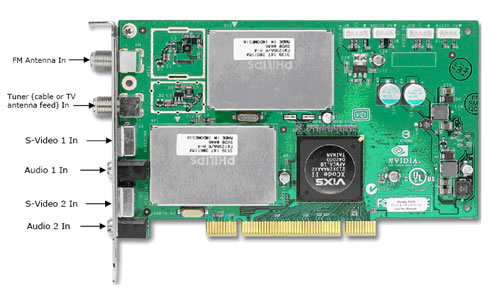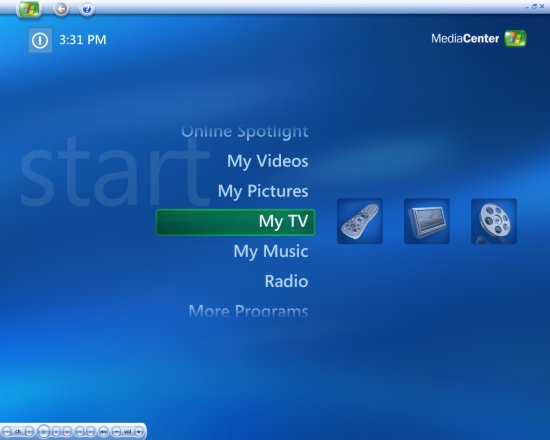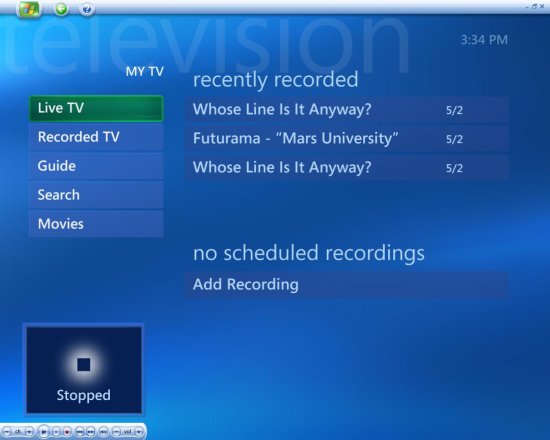The Card
The DualTV MCE fits into a PCI slot and operates alongside your video card much like ATI's Theater 550 Pro. The card is passively cooled and has no external power connections, making installation very easy. It comes with a CATV/TV antenna input, two S-VIDEO and audio inputs, and an FM antenna.
The card comes bundled with all the necessary connectors for a wide variety of home theater and audio setups, as well as a standard remote control for use with Windows Media Center. The card takes a standard single cable input and splits it into two signals internally, and the on board amplifier and splitter ensures better signal quality than having an external splitter do the job. The DualTV MCE's MPEG encoder is made by a company called Vixs, and the two tuners on it are made by Philips. Below is an illustration of the card's basic architecture.

Features
As far as features go, the DualTV MCE is fairly straightforward. It's biggest feature would be the fact that, as its name indicates, it offers dual video in, allowing you to watch and record two programs at the same time. This is essentially what cable services like TiVo and DVR offer, however because it is recording to your computer, the capacity for how much can be recorded and stored is potentially much higher.There are other smaller features of the DualTV MCE, when used with Windows Media Center Edition, that add to the overall package, such as something called MediaSqueeze. MediaSqueeze basically lets you record live TV at a lower bit rate without a major loss in quality. It also lets you translate video that's already been recorded to a lower bit rate, with 4 different quality settings: fair, good, better, and best mode. This allows you to make better use of your disk space for video archiving. NVIDIA's PureVideo is incorporated into the package, which ensures good quality digital video decoding. PureVideo can be purchased for use with any NVIDIA GPU, but the fact that it is bundled with the DualTV is a good thing. We would like to see PureVideo come bundled with graphics cards in the future as well.
Windows XP MCE
Windows XP Media Center Edition is a version of Windows that offers a variety of audio and video applications beyond what you get with the standard Windows XP OS. An interesting side note is that MCE 2005 includes many of the performance enhancements of Windows Server 2003, so it can actually outperform XP Pro systems by a small margin. The main interface for multimedia applications is easy to navigate and full of options.

Windows MCE is listed as a minimum requirement for the DualTV MCE, and is not included with the card package. Unfortunately, there is no software provided for non-MCE Windows installations. This seems a little strange to us, but our focus for this review is on the card itself, and we will be looking more in depth at Windows MCE in a future article.










68 Comments
View All Comments
hondaman - Friday, May 19, 2006 - link
FIRST thing I thought. Pretty bad review by AT standards.How does live tv look compared to REAL live tv, i.e. tv plugged right into your sat/cable reciever?
Where is the defacto standard for tv capture cards, the hauppauge? Why is this card not compared?
Will it run in linux based pvrs, and what are the tradeoffs? Is there any windows-only software that makes this card better, and isnt available for linux users, thus making it a bad choice for us?
Need WAY WAY WAY more info! Come on AT! You can do better than this!
stmok - Saturday, May 20, 2006 - link
Knowing how Nvidia acts in regards to open-source in general, I seriously doubt this solution works in Linux. You're better off getting a Hauppauge card that is well known for Linux support.As for the article itself? (I'd have to agree with the others).
(1) Where the heck is CPU usage graphs?
(2) It would be wiser if you capture from the same show with the different cards, so we can compare quality.
(3) How does it compare to those Haupauge products?
(4) Support for other OSs? (We ain't all Windows users!)
(5) I am curious of the power consumption of capture cards...How much power do they burn?
micsaund - Friday, May 19, 2006 - link
Also: "...all three of these cards use silicone tuners..."It's "silicon" -- silicone is used in completely different applications, some of which I'm sure I don't have to elaborate on ;)
guste - Friday, May 19, 2006 - link
I'm a bit disappointed as well, but not surprised. Anandtech has it's strong areas and weak areas and this is definitely one of the weaker areas. Not a big knock against the site though, as this kind of thing isn't it's bread and butter.Anyway, I was hoping to get some more data, since I currently run two Theatre 550 Pros in my MCE box and wanted to see what the CPU utilization characteristics of the nVidia dual tuner solution are. The 550 Pros are a flawless solution, other than the fact that they take two slots, so it would have helped to get a thorough review to see if it was worth it to upgrade.
DukeTogo - Friday, May 19, 2006 - link
Ditto, I wanted to like this article but...I thought it was over the top to jump on the 550 cards for only have one tuner.
As noted, not a problem - install two. We run 2 x Sapphire Theatrix 550's and they are great. If you can get the "Lite version" (ie. no remote) it's extra savings over the one with the IR remote or the ATI Elite version with the RF remote. Then you just use your MCE remote, assuming you use MCE.
I was interested in the power consumption. Subtracting off the 145W base, it seems that each config uses: (warning: validity?) I doubled the 550 solution for the case where one uses two cards.
From the article (-145W)
Idle Watch Record
NVIDIA 17 34 44
550 14 25 30
550x2 28? 50? 60?
I do own a PowerAngel so I could probably validate the 550 figures given the time on the weekend.
I'd be interested in heat output as well. Does one Nvidia card produce less heat than 2 550's ? I would assume so, but...
The channel change times was interesting, though not perhaps all that relevant if you use an IR blaster to an external set-top box. Probably only matters to those with a direct cable feed?
I'd also be very interested in an analysis of MediaSqueeze.
cpu? disk space? quality? interface/settings ? etc
Hoping to see a Part II for this article with some of the info people want to see.
mindless1 - Saturday, May 20, 2006 - link
Something looks wrong with those numbers, a card that doesn't have MPEG2 encoding should cause a larger difference between idle (watching) and recording because it's taking the CPU out of HALT state quite a bit.Trisped - Sunday, May 21, 2006 - link
That would only be true if the card was compressing the data stream so it could be sent to the video card to be decompressed. With an AIW card the data is sent strait from the tuner to the GPU, and never has to leave the board. Otherwise they would have built in a converter so it wouldn't cripple your system bus when sending the data between cards.mindless1 - Sunday, May 21, 2006 - link
No, it would be true.IF the card does not have hardware compression, AND the video is being recorded to a compressed format, THEN the CPU _MUST_ being encountering a higher load than it otherwise would. So it is with most AIW, software MPEG2 is the default isn't it? regardless of what the default is, I think wek can presume the majority of AIW users are using a compressed format.